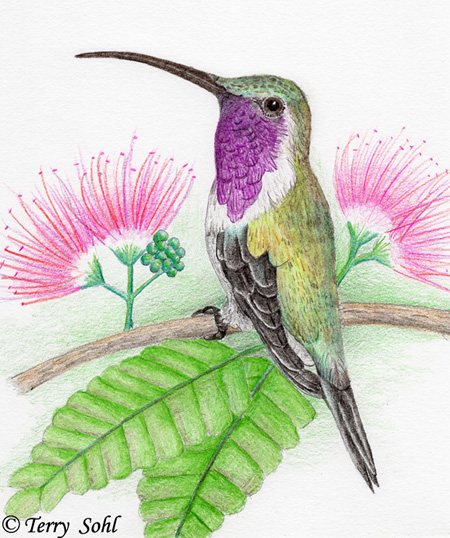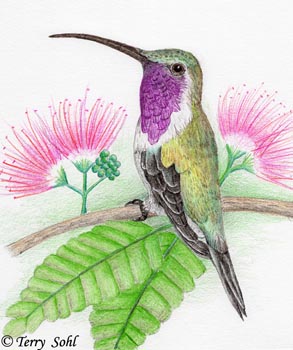| Length: 3.5 inches | Wingspan: 4 inches | Seasonality: Non-resident in South Dakota |
| ID Keys: Males - Extensive purple gorget - All - green upperparts, obviously curved bill, very small size, deeply forked tail | ||
 Lucifer Hummingbirds are also sometimes called Lucifer "Sheartails", a
moniker given to a group of similar hummingbirds with deeply forked tails.
They are birds of dry areas of Mexico, only reaching the U.S. in a few
select places. Most notably, the Big Bend area of Texas has become
known as a reliable location to find Lucifer Hummingbirds, and they also can
often be found in a few select areas of southern Arizona. The name of the
bird likely derives from the Latin meaning of "Lucifer", which is
interpreted as "light-bearing" and likely refers to the iridescent gorget of
the male.
Lucifer Hummingbirds are also sometimes called Lucifer "Sheartails", a
moniker given to a group of similar hummingbirds with deeply forked tails.
They are birds of dry areas of Mexico, only reaching the U.S. in a few
select places. Most notably, the Big Bend area of Texas has become
known as a reliable location to find Lucifer Hummingbirds, and they also can
often be found in a few select areas of southern Arizona. The name of the
bird likely derives from the Latin meaning of "Lucifer", which is
interpreted as "light-bearing" and likely refers to the iridescent gorget of
the male.
Habitat: Lucifer Hummingbirds are well adapted to desert life, preferring dry slopes with scattered desert vegetation and shrubs. They can also be found in less arid environments, including grasslands and open woodlands, especially in the southern part of their range.
Diet: Typical diet of hummingbirds, primarily nectar, but insects also comprise a portion of the diet. Young are especially fed many insects while still dependent on the female.
Behavior: Aggressive as are many hummingbird species. Males will actively defend flower patches from other hummingbirds or other intruders. Females will actively defend nest site areas from all intruders. .
Nesting: Nests are typically built on rugged rocky slopes, cholla cactus, ocotillo, or sometimes other dry habitat vegetation. The nest is made of a mix of plant material (plant down, plant fibers, leaves, or tiny stems), integrated with spider webs, and with the outside decorated with lichen or bits of bark. Females build the nest, incubate the eggs, and raise the young without help from the male.
Song: The "song" of a male Lucifer Hummingbird is a rattling flutter heard during the male's diving display flight.
Migration: Birds in the southern part of their range are probably permanent residents. However, birds that summer in the U.S., as well as those in much of northern Mexico, migrate south to central Mexico in the winter.
Interactive eBird Map: Click here to access an interactive eBird map of Lucifer Hummingbird sightings
Feeders: Will attend hummingbird feeders
Similar Species: Male may appear similar to Costa's Hummingbird, with similar purple gorget. But strongly decurved bill on the Lucifer Hummingbird, as well as other features, make it generally easy to identify in the field.
Conservation Status: No current conservation concerns, populations seem stable, and may even be expanding in the limited U.S. portion of their range.
Further Information: 1) WestTexasHummingbirds - Lucifer Hummingbird
2) Audubon Guide - Lucifer Hummingbird
3) WhatBird - Lucifer Hummingbird
Image Information: Color pencil drawing of Lucifer Hummingbird by myself (Terry Sohl)
Additional Photos: Additional Photos Coming Soon!!
| Click below for a higher-resolution map |
 |
| South Dakota Status: Non-resident in South Dakota |
Additional Lucifer Hummingbird Images
Click for a higher-resolution version of these photos

